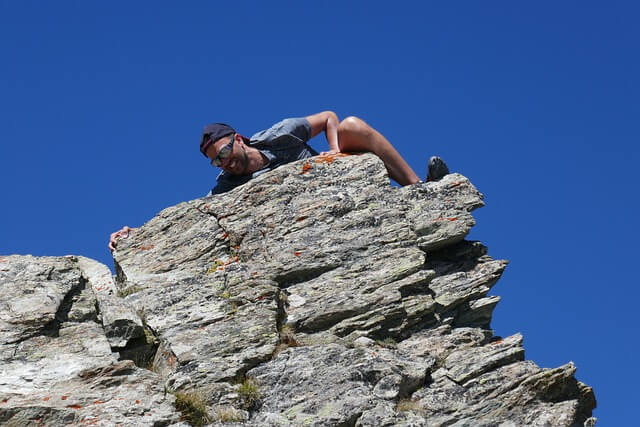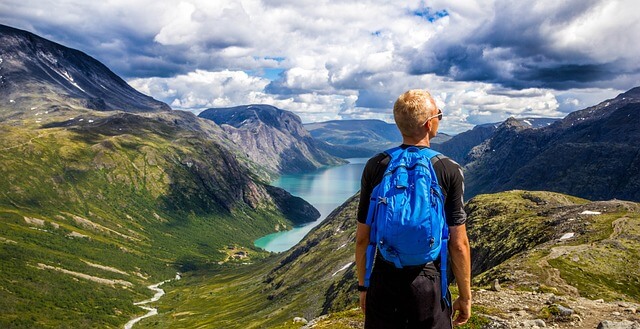Hiking is an excellent activity because of the mental and health benefits that it provides, but also because of the physical benefits. You inevitably notice that your body starts changing whenever you begin hiking. At first, you might be blindsided by all the soreness you will feel, but soon after, you will start seeing a real change.
But do the muscle mass change with hiking? Can you build muscle by hiking, or does this activity benefit your body in other ways?
That is what we are here to find out! I have been an avid hiker for years, so I have all the details about the changes you can expect to see in your body after you start hiking. If you want to find out more about this, make sure you read the entire guide.
More...

Table of Contents
What Muscles Are Worked When Hiking?
As you might suspect, hiking is not the easiest activity - it requires a certain level of physical readiness. If you have not been working out before hiking, you will notice soreness in your legs and core as soon as the first hike is over. The soreness can be mild to extreme.
The reason for the after-hike soreness is muscle fatigue from all the work your body has to put in to get you through the hike. Even though the entire body is engaged, the legs and core do most of the work, but you can also engage the muscles in your arms, shoulders, and back if you wish to. Let’s look into the muscles in more detail to see what they do while you are hiking:
Hamstrings
The hamstrings are muscles on the back of your upper leg. They start at the hip and extend to the knee. They help you bend and extend the knee and entire leg (also improve leg muscle if you are walking uphill), while they also help with regular walking and running. When hiking, they will put in a lot of work to get you up and down a mountain, hill, or trail.
Quadriceps
The quadriceps are muscles on the front of the upper leg or the thigh. They also help you make movements with your legs while engaged in actions like walking, running, or jumping.
Calves
The calves are muscles located on the back of the lower leg. They are also essential for movement because they are connected to the foot and ankle. While making a forward motion on an uphill or downhill hike, you might feel severe pain in your calf muscles because they take quite a beating when you hike.
Glutes
The glutes are muscles located around your buttocks. This group includes three muscles: gluteus maximus, gluteus medius and gluteus minimus. These muscles help you keep your body in an upright position while they also help push the body forwards whenever you need to move. You can expect them to work from the first to the last step in a hike.
Core muscles
If you thought that the core consists only of the ab muscles, think again! Various abdomen, hips, and spine muscles belong to this muscle group. Whenever you hike, they will help you balance the workload between the upper and lower body. They also do a great job of protecting the spine from too much weight.
Back muscles
The back muscles can also take a beating on hikes, especially if you are carrying a heavy backpack on your back. These muscles are connected to your arms, shoulders, and head, so you must be careful not to injure or strain them. If you are planning to carry a lot of weight on your back, make sure to adjust the backpack straps and add protective straps around your abdomen and chest to distribute the added weight.
Arms and shoulders
The arms and shoulders do not get much exercise while you hike, except if you carry trekking poles. With the poles, you can also put your arms and shoulders to work, helping them leaner and more toned. Hiking with trekking poles is a great way to exercise these muscles if you do not want to hit the gym and deal with dumbbells.
Extra information
As you can see, you can turn any hike into a full-body workout, hitting many different muscle groups at once. It might take a while before you can get on the more challenging hiking trails, but that depends on your initial shape and how much work you put in once you start hiking.
Try to start with shorter, less demanding hikes that do not include considerable altitude differences. As you get into hiking more and more, you can move on to the more challenging hikes that will also help with muscle building.
Remember to always take a while to recover after a hike. At first, you will feel quite sore from all the hiking. After a while, your body will get used to it, but you will still need to recover. After each hike, get some beauty sleep, drink lots of fluids, and do not forget to eat healthy meals!
If you do all this, I do not doubt that you will see a drastic change in how your body looks and feels within a couple of months. You will stand taller and feel better while being more relaxed. Since the benefits of hiking are amazing, I encourage you to at least try hiking once and see if it is something that fits you!

Does Hiking Build Muscle & What Does Hiking Do To Your Body Shape?
I have explained the muscles you can expect to work on when hiking. But what I get asked often is what kind of body you can expect to get from hiking. In other words, the question is if hiking builds muscle, and if it does, how much muscle will it help you build?
If you are worried that hiking will make you bulky and extra muscular, you can relax and take a breather. Hiking is a great activity that helps you with muscle toning, not increasing muscle size like in a gym. Hiking will not turn you into a full-on bodybuilder, so this might not be the best activity for you if that is what you are looking for.
To build muscle, you should try going to the gym and hitting the dumbbells. To increase muscle strength and tone the muscles, you should go hiking. It is, and I am certain, one of the best types of exercise you can get for toning your body and losing weight.
But these are only two of the reasons why you should consider hiking regularly. Hiking has many other benefits, like better mental health, a calmer demeanor, and better overall health.
So, in short – hiking does help muscles growth because it keeps them constantly engaged, but the growth will not be significant. Hiking is more likely to help you strengthen the muscles while toning them.
What Kind Of Body Does Hiking Give You?
Think about this for a second – your body uses up to 200 muscles and even more when taking a step. Can you imagine the work your body puts in to help you get through a challenging, long trail that also involves a considerable altitude change? The work must be tremendous, so your body goes through quite a workout.
As I mentioned before, within a few months of hiking, you should expect to see a change in your body (also body weight). The type of body you can get from this activity is mainly leaner and more toned but very strong in general. It is not the best for building muscle or maintaining a certain weight, as hiking will make you lose a lot of weight.
If losing weight is your goal, you should have no problem reaching it. That is, of course, as long as you pair the hikes with a good diet that is not restraining in any way but allows you to get all the nutrients you need. The nutrients will encourage your body to change for the better, so you will get into your desired shape in no time.
If you want to see a more significant change faster:
Try consuming less food before and during hikes while maintaining a healthy diet.
Push yourself with the hikes, but be careful not to injure yourself.
Always listen to your body and its demands; it is the best way to get the most from anything you do!
Wrap Up
Hiking is a great way to get toned and lose some weight. It does help strengthen the muscles but does not do much to give you bigger muscles/increase muscle mass. Those who wish to build muscle should consider going to a local gym to get their desired body shape, but they can also pair hiking with going to the gym. After all, hiking has many benefits you should not miss out on.
- Are Merrell Shoes Good? – An Unbiased Review of Merrell Footwear - December 9, 2023
- Where Are Merrell Shoes Made? - December 9, 2023
- Camping in 40-degree Weather: Tips and Tricks - September 25, 2023

![Do Columbia Shoes Run Big or Small? [Here is the Answer] Do Columbia Shoes Run Big or Small? [Here is the Answer]](https://grandcircletrails.com/wp-content/uploads/2022/04/Do-Columbia-Shoes-Run-Big-or-Small-1-150x150.jpg)
![Do Columbia Jackets Shrink? [Here Is The Answer] Do Columbia Jackets Shrink? [Here Is The Answer]](https://grandcircletrails.com/wp-content/uploads/2022/05/Do-Columbia-Jackets-Shrink-150x150.jpg)
![How Old Do You Have To Be To Go Camping? [Answer Here] How Old Do You Have To Be To Go Camping? [Answer Here]](https://grandcircletrails.com/wp-content/uploads/2022/05/How-Old-Do-You-Have-To-Be-To-Go-Camping-150x150.jpg)
![How Hot Is a Campfire? [Here Is the Answer] How Hot Is a Campfire? [Here Is the Answer]](https://grandcircletrails.com/wp-content/uploads/2022/06/How-Hot-Is-a-Campfire-150x150.jpg)
![How Long Does Butane Canister Last? [Detailed Answer] How Long Does Butane Canister Last? [Detailed Answer]](https://grandcircletrails.com/wp-content/uploads/2022/04/How-Long-Does-Butane-Canister-Last-1-150x150.jpg)
![How Long Will Ice Last in a Yeti Cooler? [Read Here] How Long Will Ice Last in a Yeti Cooler? [Read Here]](https://grandcircletrails.com/wp-content/uploads/2022/02/How-Long-Will-Ice-Last-in-a-Yeti-Cooler-1-150x150.jpg)